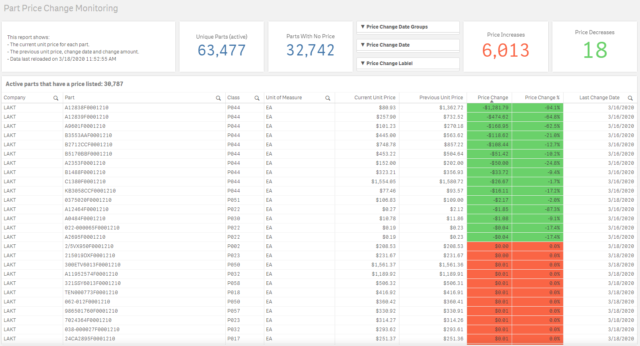Today I had a friendly reminder, that as a Qlik developer, I sometimes take for granted the power of the platform.
I had a classic business problem to solve with a manufacturing client. It wasn’t the first time I’ve heard this request, and given how hard it can be to build solid reporting within your ERP system, it probably won’t be the last. The questions went like this:
- “We buy thousands of parts from hundreds of vendors – how do we know when prices have been updated in the ERP system?”
- “How can we monitor how much prices are changing and how often?”
- “How can we monitor which vendors are changing prices?”
- “What if we want to see which buyers are negotiating the best?”
- “How can we see what the price was back on the date when the part was committed to a project?”
Our starting point was to extract today’s prices from the ERP system, and store these down into a qvd.
We then created an ETL process that will pull the latest prices each day, compare these to the day before, record any changes in price, stamp them with a date, and re-create the qvd.
We then hopped over to the front end in Qlik and created a report to show current prices, previous prices, and highlight volume and scale of price changes.
We validated the data, scheduled the report to re-run at the end of each day, and published this out to the Qlik Hub for a wider audience to use
.
2 hours later – business problem solved!
And all within a single tool, thanks to the broad library of Qlik data connections, the power of the Qlik ETL engine, the ability to rapidly build reports, and the slick publishing workflow.
The only piece we’re missing is an exception based email notification to let the right people know when a price change has occurred…..and of course we can take care of this with Qlik’s NPrinting module. We can can even kick off the notification using the REST APIs directly from the Qlik script. Now that’s what I call ‘end-to-end’ Business Intelligence.
More Insights
-
Qlik to Power BI Migration

-
Client Product Reporting in FX Sales & Trading

-
Consolidating Financials for Multiple Acquisitions

-
How Machine Learning Can Transform the Financial Sector in 2024

-
Tracking Key Business Metrics using Power BI

-
Update on the future of Talend Open Studio

-
Multinational Bank’s Need of Fluid Understanding for their FX Pricing

-
Building a Single View of a Customer’s Portfolio to Support Regulatory Compliance

-
Exploring Change Data Capture (CDC)

-
🔍 Excel vs. BI Tools: Why It's Time to Evolve Your Data Strategy
